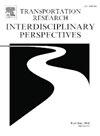Exploring balanced modal split for freight transportation system: A case of the central region of South Africa
IF 3.8
Q2 TRANSPORTATION
Transportation Research Interdisciplinary Perspectives
Pub Date : 2025-05-01
DOI:10.1016/j.trip.2025.101479
引用次数: 0
Abstract
Ensuring sustainability in transportation systems demands a harmonious distribution of freight. In the regional context of South Africa, road and rail transportation play pivotal roles, yet a significant imbalance exists, posing sustainability challenges. This study aims to identify key factors influencing freight transport, develop empirical cost models, and simulate scenarios to achieve equilibrium in regional freight distribution. Employing survey research, data was collected from freight companies and analysed using inferential statistics and empirical modelling. It employed a utility choice function model for simulating scenarios conducive to achieving a balanced freight transport system. Findings suggest that currently, compared to rail freight, road freight transport dominates, leading to an imbalanced system. Critical factors that influence include load cost, loading/offloading times, fuel expenses, and travel duration. However, sensitivity analyses revealed that targeted reductions in travel time, loading/offloading times, load cost, and fuel expenses could lead to a substantial shift towards rail transport, promoting a more balanced system. This study provides actionable insights for stakeholders. By addressing influential variables, such as load cost, loading/offloading times, fuel expenses, and travel duration, the freight industry can work towards equitable coexistence of road and rail transport. This study highlights the prevalence of road-based freight transport in the region and demonstrates the potential for equilibrium through interventions in key variables.
探讨货物运输系统的平衡模式分割:以南非中部地区为例
确保运输系统的可持续性需要货物的和谐分配。在南非的区域背景下,公路和铁路运输发挥着关键作用,但存在严重的不平衡,构成了可持续发展的挑战。本研究旨在找出影响货物运输的关键因素,建立实证成本模型,并进行情景模拟,以实现区域货物运输均衡。采用调查研究,从货运公司收集数据,并使用推论统计和实证模型进行分析。它采用效用选择函数模型来模拟有利于实现平衡货运系统的情景。研究结果表明,目前,与铁路货运相比,公路货运占主导地位,导致系统不平衡。影响的关键因素包括装载成本、装卸时间、燃料费用和旅行时间。然而,敏感性分析显示,有针对性地减少旅行时间、装卸时间、装载成本和燃料费用,可能会导致铁路运输的实质性转变,促进一个更平衡的系统。本研究为利益相关者提供了可操作的见解。通过解决有影响的变量,如装载成本、装卸时间、燃料费用和旅行时间,货运业可以努力实现公路和铁路运输的公平共存。这项研究强调了该地区公路货运的普遍性,并通过对关键变量的干预证明了平衡的潜力。
本文章由计算机程序翻译,如有差异,请以英文原文为准。
求助全文
约1分钟内获得全文
求助全文
来源期刊

Transportation Research Interdisciplinary Perspectives
Engineering-Automotive Engineering
CiteScore
12.90
自引率
0.00%
发文量
185
审稿时长
22 weeks
 求助内容:
求助内容: 应助结果提醒方式:
应助结果提醒方式:


